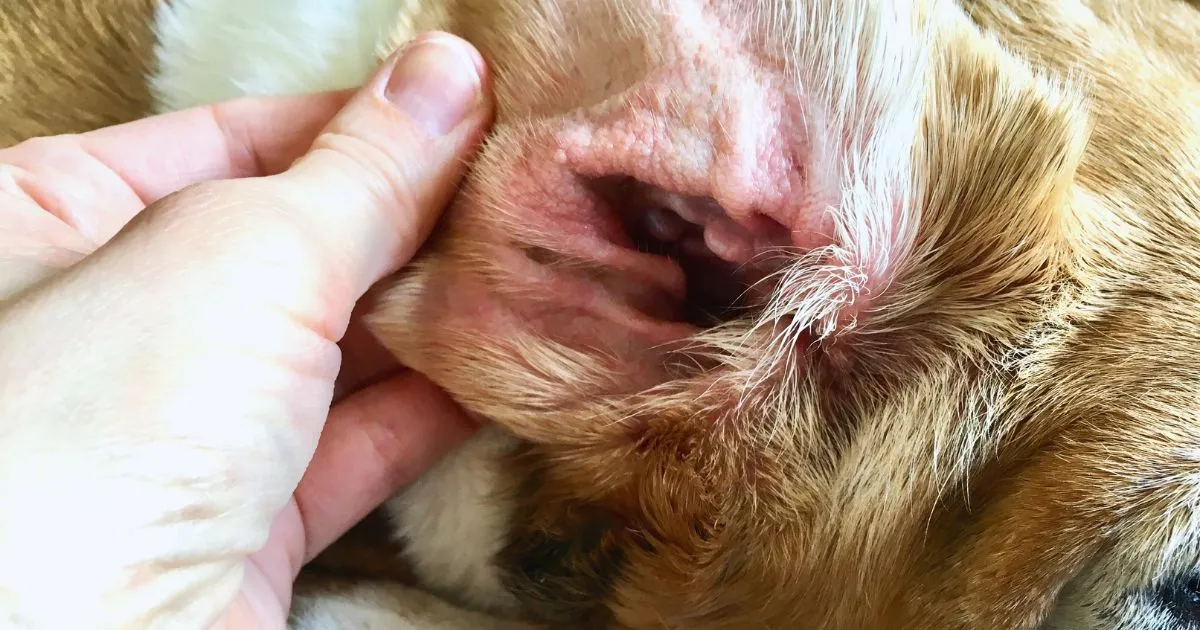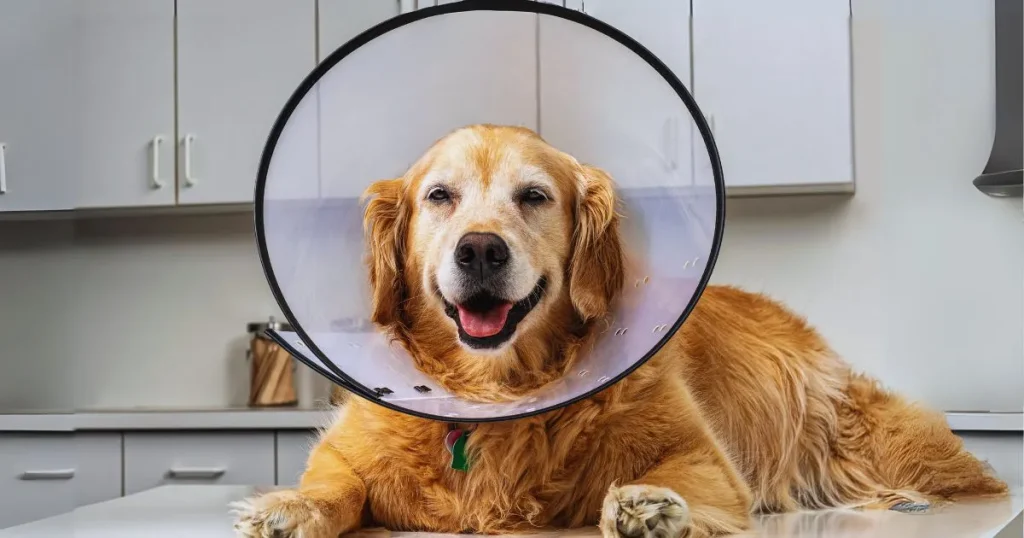Dogs Ear Swollen: Causes, Symptoms, and Treatments

Dogs Ear Swollen is the most common problem for pet owners who might face with their furry pets. This condition may affect different parts of the ear, including the ear flap (pina), the ear canal, as well as the surrounding tissue. When you notice your dog’s ears are swollen, it can be worrying. However, identifying the probable causes of this problem is the first step to finding a solution and assuring your pet’s comfort. In this article, we’ll discuss why dogs’ ears swell up, what symptoms to check for, and the important steps to take to determine what’s wrong and how you can help them.
What is an aural hematoma?
An ear hematoma in dogs is a small lump of blood that collects under the skin and in the soft tissue (pinna) of the ear flap. Ear hematomas in dogs can be very uncomfortable and if not treated, they may lead to serious damage that clogs the ear canal and affects your dog’s hearing. If your dog shows symptoms of an ear hematoma, you should schedule an appointment with your veterinarian quickly.
Common Causes of Dogs Ear swollen
Dogs ear swollen most commonly develops when a dog aggressively shakes their head or scratches their ear. The dog ear tissue flap (or “pinna”) is so thin while it is injured, the blood vessels can damage. Other symptoms may include redness, scabs or crusts, discharge, fatigue, and walking in circles. Several underlying conditions could be the reason:
- Ear infections (otitis externa)
- Allergies
- Ear mites (very rare in dogs)
- Foreign objects
- Hematomas
- Trauma
- Tumors
- Immune disorder
The following symptoms of Dogs Ear Swollen
The main symptom of an ear hematoma is swelling of the ear flap. In the initial stages, the ear may also appear larger and thicker; it is often known as the “cauliflower ear”. Your dog’s pain and irritation may reason several symptoms, including hematomas, allergic reactions, and even tumors.
- Head tilted to one side of the hematoma.
- Pain or discomfort.
- Scratching or rubbing the affected ear
- Ear odor
- Head-Shaking
- Redness or inflammation
- Hearing loss
How Veterinarians Diagnose Dogs Ear Swollen

Dog ear swollen is diagnosed through a physical test, with the veterinarian that specialize in characteristic signs and symptoms which include swelling, redness, or visible lumps. The veterinarian may take a swab from inside the ear and analyze it under a microscope to look if there is any yeast or bacteria.
It’s important to address the main cause of your dog’s head-shaking. Your veterinarian may recommend additional testing, such as aspiration using a needle, to ensure that the fluid inside the hematoma is only blood. Veterinarians normally use blood tests to evaluate your dog’s normal fitness.
Treatment of Dogs Ear Swollen
Your veterinarian will need to repair your canine’s swollen ear. It’s true if this swelling is so large then it can be blocking the dog’s ear canal which causes the dog extreme pain or discomfort.
To reduce swelling there are several treatment options to consider
Aspiration:
Some owners may recommend this treatment as it provides rapid comfort and does not require surgery. This procedure involves the insertion of a thin needle attached to a syringe into the hematoma to drain the fluid. Instilling a steroid may reduce ear inflammation, itchiness, and swelling. This treatment will be repeated a week later
Surgery:

In surgery, an incision is made to drain the blood, and then stitch the entire area that was swollen through the ear. This step helps relieve pressure and discomfort in the affected ear. Next, the veterinarian gently stitches the wound site to inspire recovery and avoid infection. E-Collar must be worn to prevent the dog from scratching or rubbing the surgical part, which could compromise healing. Follow-up appointments with your veterinarian are crucial for monitoring progress and ensuring good enough recovery.
Medication:
Medicine for a dog’s swollen ears is essential for alleviating discomfort and treating the underlying problem. Veterinarians prescribe medications such as antibiotics, anti-inflammatories, and ear drops for infections, or pain relievers.
How to Prevent Dog’s Ear Swollen
The main cause of dog ear hematomas is head-shaking. The intention of treating the hematoma is to prevent it from recurring. After draining the blood, there is still space where blood may continue to pool. In this case, veterinarians use corticosteroids and sutures to cure the infection and prevent blood from collecting in the same location.
To avoid an aural hematoma, you must prevent the underlying reason:
- Regular Ear Cleaning: Routinely examine your dog’s ears for signs of redness, discharge, or odor. Clean them as recommended by your veterinarian to remove dirt and prevent infections.
- Allergy Management: Identify and manage any allergies your dog may have to minimize the risk of ear trauma from scratching. Proper follow-up care and regular monitoring are critical to preventing not only recurrences but also the possibility of a hematoma in the other ear.
- Parasite Prevention: Keep your dog up-to-date on parasite prevention, including regular flea and tick treatments. Parasites like mites can cause ear irritation and swelling.
- Proper Grooming: To prevent a recurrence and avoid the formation of a hematoma in the opposite ear, it is essential to provide proper follow-up care and frequently monitor the situation. It is crucial to take preventative measures to avoid swelling in a dog’s ear.
It is essential to take preventive measures to prevent swelling in a dog’s ear.
Dogs with swollen ears may have infections, allergies, injuries, or foreign objects in their ears. Regular veterinary check-ups and proper grooming will help prevent ear swelling and maintain your dog’s overall health.
Frequently Asked Questions:
Q1: Why is a dog‘s ear swollen?
Swelling in a canine‘s ear may be caused by a variety of factors, including infections (bacterial or fungal), ear mites, allergic reactions, overseas items stuck in the ear, trauma, or even underlying health issues such as autoimmune illnesses. identifying the underlying reason is vital for successful treatment.
Q2: How can i recognize if my dog‘s ear is swelled from an contamination?
Symptoms of an ear infection in dogs include obvious swelling, redness inside the ear, discharge (which may smell unpleasant), increased scratching or pawing at the ear, and visible discomfort or ache. If you experience these signs, schedule an appointment along with your veterinarian to diagnose and treat the illness.
Q3: Which canine breeds are more likely to get ear swelling?
Indeed, certain dog breeds are more prone to ear issues that bring about swelling. Breeds such as Labrador Retrievers, Basset Hounds, and Cocker Spaniels who have long, floppy ears are extra prone due to decreased air movement in their ears, which can inspire the growth of germs and fungi.
Q4: How are dogs‘ swollen ears treated?
The underlying purpose of enlarged ears in dogs determines an appropriate remedy. this will include antibiotics or antifungal medications for infections, parasite remedies for ear mites, anti-inflammatory meds for allergic reactions, or surgery in severe situations. A complete assessment by a veterinarian is required to set up the most effective treatment.
Q5: How can i stop the swelling in my dog’s ears?
Preventive strategies consist of maintaining general health and hygiene up to date, treating ear problems as soon as they rise up. Cleaning your dog’s ears on a regular basis using a solution that your veterinarian recommends, and dealing with your dog’s diet if they have allergic reactions. Similarly reducing the chance of swelling is automatically observing your canine’s behavior and ear fitness. This can assist identify possible issues early.




